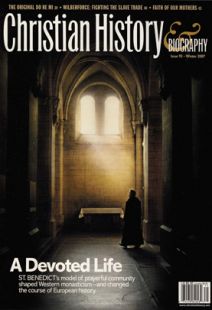Living like a monk in the “real world”
Cluny’s second abbot, Odo, was distressed by the way local nobles governed by sheer power. He wanted
worldly rulers to rule justly and for the common good rather than for selfish motives. So he wrote a biography of Gerald of Aurillac (855-909), a count who lived in the world and wielded the sword of government in a fully Christian, quasi-monastic manner. By Gerald's example, Odo hoped to show how one might adapt to secular circumstances the basic Christian principles that monks aspired to live out—justice, honesty, humility, and selfless love.
Gerald was the last representative of a noble family that had served the Carolingian rulers. He was trained as a warrior—athletic enough to vault over the back of a horse—but was also educated in Latin and classical literature. He wanted to join a monastery, but a bishop counseled that he could better use his status and privileges for God as a layman.
So Gerald lived as much like a monk as he could without actually becoming one. He eschewed marriage (his family lineage died out with him), wore a hidden tonsure, fasted to concentrate his mind while judging disputes within the “county” he governed, drank and ate sparingly even when hosting the feasts required by his status, ate meals with the poor, dressed soberly, and founded monasteries with his family’s resources. His temperateness and discretion were inspired not by contempt for God’s good gifts, but by a desire for better self-control so that he could serve God more effectively.
He exercised his God-given military responsibilities solely to defend the innocent and, according to Odo, “never stained his sword with human blood.” Indeed, Gerald and his men fought with the “backs of their swords” and with “spears reversed” to show that God alone gave them victory. Gerald’s very restricted use of war foreshadowed the rules for Christian military conduct (such as protection for civilians) pioneered by Cluny’s monks in the 1000s.
“This man of God,” Odo insisted, was “an example to the mighty, [and thus] let them see how they may imitate him as one of themselves held up for their example.”
By Dennis Martin
[Christian History originally published this article in Christian History Issue #93 in 2007]
Next articles
Benedict, a devoted life: Recommended Resources
Dig deeper into this issue's theme
The authors and editorsChristian History Timeline: Benedict and the Rise of Western Monasticism
From its roots in the early Eastern church, through the Benedictine centuries, to the birth of new kinds of religious orders in the Middle Ages
compiled by Antonia Ryan with contributions from Carmen Acevedo ButcherSupport us
Christian History Institute (CHI) is a non-profit Pennsylvania corporation founded in 1982. Your donations support the continuation of this ministry
Donate




